A Self-Powered Transparent Photodetector Based on Detached Vertical (In,Ga)N Nanowires with 360° Omnidirectional Detection for Underwater Wireless Optical Communication
Abstract
:1. Introduction
2. Experiments and Methods
2.1. Preparation of (In,Ga)N NWs
2.2. Lift-Off Procedure of (In,Ga)N NW Films
2.3. Fabrication of Self-Powered (In,Ga)N PEC PD
2.4. Characterization and Measurement Methods
3. Results and Discussion
4. Conclusions
Supplementary Materials
Author Contributions
Funding
Data Availability Statement
Conflicts of Interest
References
- Chen, H.L.; Chen, X.W.; Lu, J.; Liu, X.Y.; Shi, J.R.; Zheng, L.R.; Liu, R.; Zhou, X.L.; Tian, P.F. Toward long-distance underwater wireless optical communication based on a high-sensitivity single photon avalanche diode. IEEE Photonics J. 2020, 12, 7902510. [Google Scholar] [CrossRef]
- Lin, R.Z.; Liu, X.Y.; Zhou, G.F.; Qian, Z.Y.; Cui, X.G.; Tian, P.F. InGaN micro-LED array enabled advanced underwater wireless optical communication and underwater charging. Adv. Opt. Mater. 2021, 9, 2002211. [Google Scholar] [CrossRef]
- Liu, X.; Yi, S.; Zhou, X.; Zhang, S.; Fang, Z.; Qiu, Z.; Hu, L.; Cong, C.; Zheng, L.; Liu, R.; et al. CMOS monolithic photodetector with a built-in 2-dimensional light direction sensor for laser diode based underwater wireless optical communications. Opt. Express 2021, 29, 16197–16204. [Google Scholar] [CrossRef]
- Yu, D.J.; Cao, F.; Gu, Y.; Han, Z.Y.; Liu, J.X.; Huang, B.; Xu, X.B.; Zeng, H.B. Broadband and sensitive two-dimensional halide perovskite photodetector for full-spectrum underwater optical communication. Nano Res. 2021, 14, 1210–1217. [Google Scholar] [CrossRef]
- Sun, X.B.; Kang, C.H.; Kong, M.W.; Alkhazragi, O.; Guo, Y.J.; Ouhssain, M.; Weng, Y.; Jones, B.H.; Ng, T.K.; Ooi, B.S. A review on practical considerations and solutions in underwater wireless optical communication. J. Lightwave Technol. 2020, 38, 421–431. [Google Scholar] [CrossRef] [Green Version]
- Zhang, J.Y.; Zhou, M.; Wu, D.M.; Bian, L.F.; Zhao, Y.K.; Qin, H.; Yang, W.X.; Wu, Y.Y.; Xing, Z.W.; Lu, S.L. Dual-wavelength visible photodetector based on vertical (In,Ga)N nanowires grown by molecular beam epitaxy. RSC Adv. 2021, 11, 15632–15638. [Google Scholar] [CrossRef]
- Xing, Z.W.; Zhao, Y.K.; Bian, L.F.; Zhang, J.Y.; Zhou, M.; Yang, W.X.; Wu, Y.Y.; Jiang, M.; Long, J.H.; Lu, S.L. Economically detaching transparent and flexible (Al,Ga)N nanowire films with improved photoelectric response in view of ultraviolet photodetectors. Mater. Adv. 2021, 2, 1006–1015. [Google Scholar] [CrossRef]
- Zhou, M.; Qiu, H.B.; He, T.; Zhang, J.Y.; Yang, W.X.; Lu, S.L.; Bian, L.F.; Zhao, Y.K. UV photodetector based on vertical (Al, Ga)N nanowires with graphene electrode and Si substrate. Phys. Status Solidi A 2020, 217, 2000061. [Google Scholar] [CrossRef]
- Junseok, J.; Xiao, W.Q.; Janghwan, C.; Kwon, J.D.; Hoon, S.D.; Sunah, K.; Kyun, K.B.; Hyuk, J.J.; Seok, Y.W.; Seok, C.Y.; et al. Remote heteroepitaxy of GaN microrod heterostructures for deformable light-emitting diodes and wafer recycle. Sci. Adv. 2020, 6, eaaz5180. [Google Scholar] [CrossRef]
- Zhao, Y.K.; Xing, Z.W.; Geelhaar, L.; Zhang, J.Y.; Yang, W.X.; Auzelle, T.; Wu, Y.Y.; Bian, L.F.; Lu, S.L. Detaching (In,Ga)N nanowire films for devices requiring high flexibility and transmittance. ACS Appl. Nano Mater. 2020, 3, 9943–9950. [Google Scholar] [CrossRef]
- Ren, X.H.; Wang, B.; Huang, Z.Y.; Qiao, H.; Duan, C.G.; Zhou, Y.; Zhong, J.X.; Wang, Z.Y.; Qi, X. Flexible self-powered photoelectrochemical-type photodetector based on 2D WS2-graphene heterojunction. FlatChem 2021, 25, 100215. [Google Scholar] [CrossRef]
- Wang, D.H.; Liu, X.; Fang, S.; Huang, C.; Kang, Y.; Yu, H.B.; Liu, Z.L.; Zhang, H.C.; Long, R.; Xiong, Y.J.; et al. Pt/AlGaN nanoarchitecture: Toward high responsivity, self-powered ultraviolet-sensitive photodetection. Nano Lett. 2021, 21, 120–129. [Google Scholar] [CrossRef]
- Fang, H.J.; Zheng, C.; Wu, L.L.; Li, Y.; Cai, J.; Hu, M.X.; Fang, X.S.; Ma, R.; Wang, Q.; Wang, H. Solution-processed self-powered transparent ultraviolet photodetectors with ultrafast response speed for high-performance communication system. Adv. Funct. Mater. 2019, 29, 1809013. [Google Scholar] [CrossRef]
- Wang, D.H.; Huang, C.; Liu, X.; Zhang, H.C.; Yu, H.B.; Fang, S.; Ooi, B.S.; Mi, Z.T.; He, J.-H.; Sun, H.D. Highly uniform, self-assembled AlGaN nanowires for self-powered solar-blind photodetector with fast-response speed and high responsivity. Adv. Opt. Mater. 2020, 9, 2000893. [Google Scholar] [CrossRef]
- Fang, S.; Wang, D.H.; Wang, X.N.; Liu, X.; Kang, Y.; Yu, H.B.; Zhang, H.C.; Hu, W.; He, J.H.; Sun, H.D.; et al. Tuning the charge transfer dynamics of the nanostructured GaN photoelectrodes for efficient photoelectrochemical detection in the ultraviolet band. Adv. Funct. Mater. 2021, 31, 2103007. [Google Scholar] [CrossRef]
- Lien, D.-H.; Wang, H.-P.; Chen, S.-B.; Chi, Y.-C.; Wu, C.-L.; Lin, G.-R.; Liao, Y.-C.; He, J.-H. 360° omnidirectional, printable and transparent photodetectors for flexible optoelectronics. NPJ Flex. Electron. 2018, 2, 19. [Google Scholar] [CrossRef] [Green Version]
- Premachandra, C.; Tamaki, M. A hybrid camera system for high-resolutionization of target objects in omnidirectional Images. IEEE Sens. J. 2021, 21, 10752–10760. [Google Scholar] [CrossRef]
- Zhang, J.Y.; Lu, S.L.; Zhao, Y.K.; Xing, Z.W. Invisible Semiconductor Device and Its Preparation Method and Application. CHN Pat. 202010517504.6, 6 June 2020. [Google Scholar]
- Chu, H.C.; Lai, Y. Ultrathin invisibility cloaks based on metasurfaces. Infrared Laser Eng. 2020, 49, 20201038. [Google Scholar] [CrossRef]
- Zhang, X.G.; Sun, Y.L.; Yu, Q.; Cheng, Q.; Jiang, W.X.; Qiu, C.W.; Cui, T.J. Smart doppler cloak operating in broad band and full polarizations. Adv. Mater. 2021, 33, 2007966. [Google Scholar] [CrossRef] [PubMed]
- Li, R. Research on Omnidirectional Matched Transparent Invisible Material. Master’s Thesis, Zhejiang University, Hangzhou, China, 2020. [Google Scholar]
- Dai, X.; Messanvi, A.; Zhang, H.Z.; Durand, C.; Eymery, J.; Bougerol, C.; Julien, F.H.; Tchernycheva, M. Flexible light-emitting diodes based on vertical nitride nanowires. Nano Lett. 2015, 15, 6958–6964. [Google Scholar] [CrossRef] [Green Version]
- Briere, G.; Ni, P.; Heron, S.; Chenot, S.; Vezian, S.; Brandli, V.; Damilano, B.; Duboz, J.-Y.; Iwanaga, M.; Genevet, P. An etching-free approach toward large-scale light-emitting metasurfaces. Adv. Opt. Mater. 2019, 7, 1801271. [Google Scholar] [CrossRef]
- Zhang, Y.; Xu, Y.; Guo, J.; Zhang, X.; Liu, X.; Fu, Y.; Zhang, F.; Ma, C.; Shi, Z.; Cao, R.; et al. Designing of 0D/2D mixed-dimensional van der waals heterojunction over ultrathin g-C3N4 for high-performance flexible self-powered photodetector. Chem. Eng. J. 2021, 420, 129556. [Google Scholar] [CrossRef]
- Li, J.; Xi, X.; Lin, S.; Ma, Z.H.; Li, X.D.; Zhao, L.X. Ultrahigh sensitivity graphene/nanoporous GaN ultraviolet photodetectors. ACS Appl. Mater. Interfaces 2020, 12, 11965–11971. [Google Scholar] [CrossRef]
- Zhang, K.; Ma, M.; Li, P.; Wang, D.H.; Park, J.H. Water splitting progress in tandem devices: Moving photolysis beyond electrolysis. Adv. Energy Mater. 2016, 6, 1600602. [Google Scholar] [CrossRef]
- Grätzel, M. Photoelectrochemical cells. Nature 2001, 414, 338–344. [Google Scholar] [CrossRef] [PubMed]
- Valagiannopoulos, C.; Tsiftsis, T.A.; Kovanis, V. Metasurface-enabled interference mitigation in visible light communication architectures. J. Opt. 2019, 21, 115702. [Google Scholar] [CrossRef] [Green Version]
- Tagay, Z.; Valagiannopoulos, C. Highly selective transmission and absorption from metasurfaces of periodically corrugated cylindrical particles. Phys. Rev. B 2018, 98, 115306. [Google Scholar] [CrossRef]
- Xu, Y.Q.; Hua, J.; Gong, Z.; Zhao, W.; Zhang, Z.Q.; Xie, C.Y.; Chen, Z.T.; Chen, J.F. Visible light communication using dual camera on one smartphone. Opt. Express 2018, 26, 34609–34621. [Google Scholar] [CrossRef]
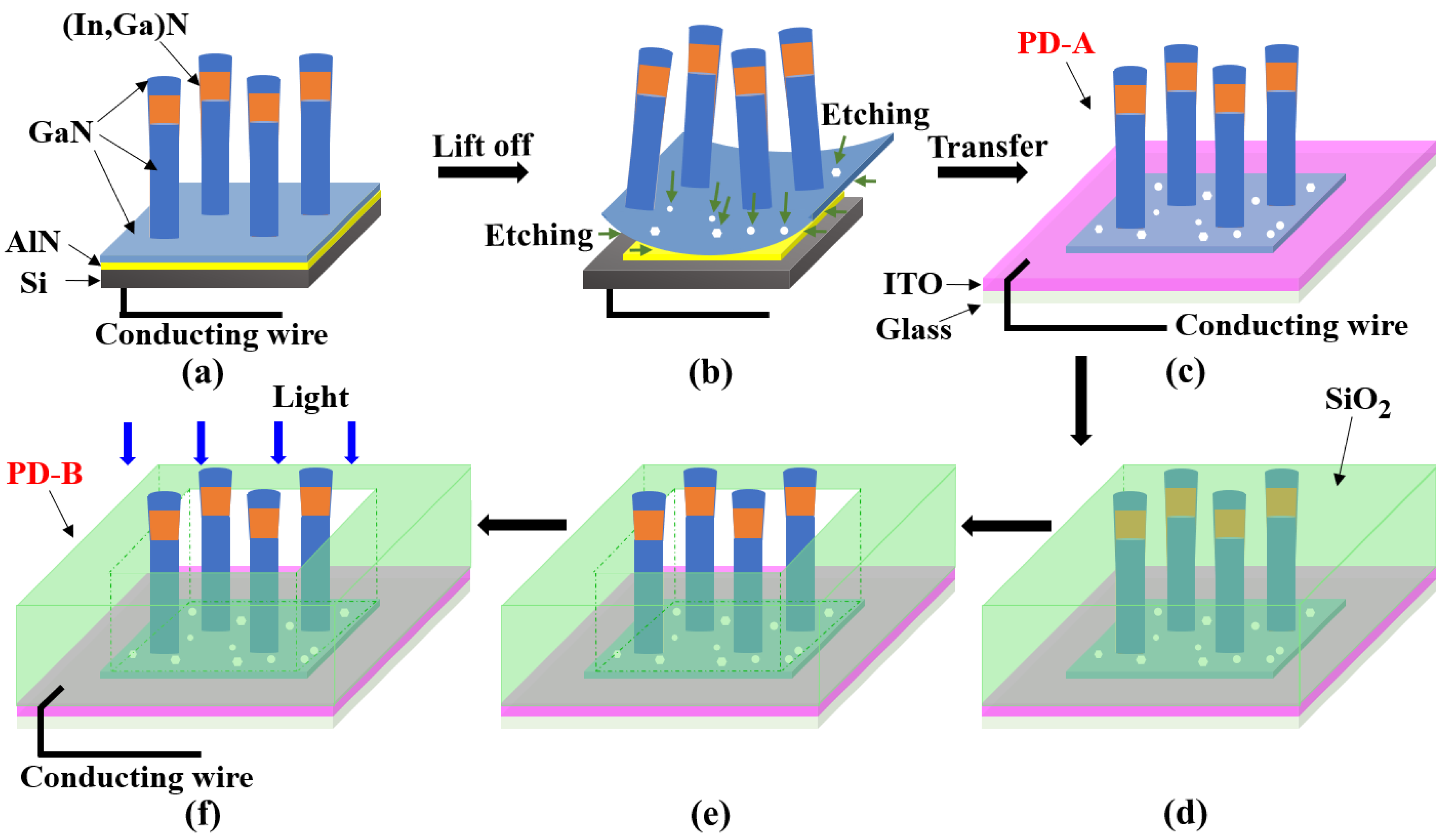
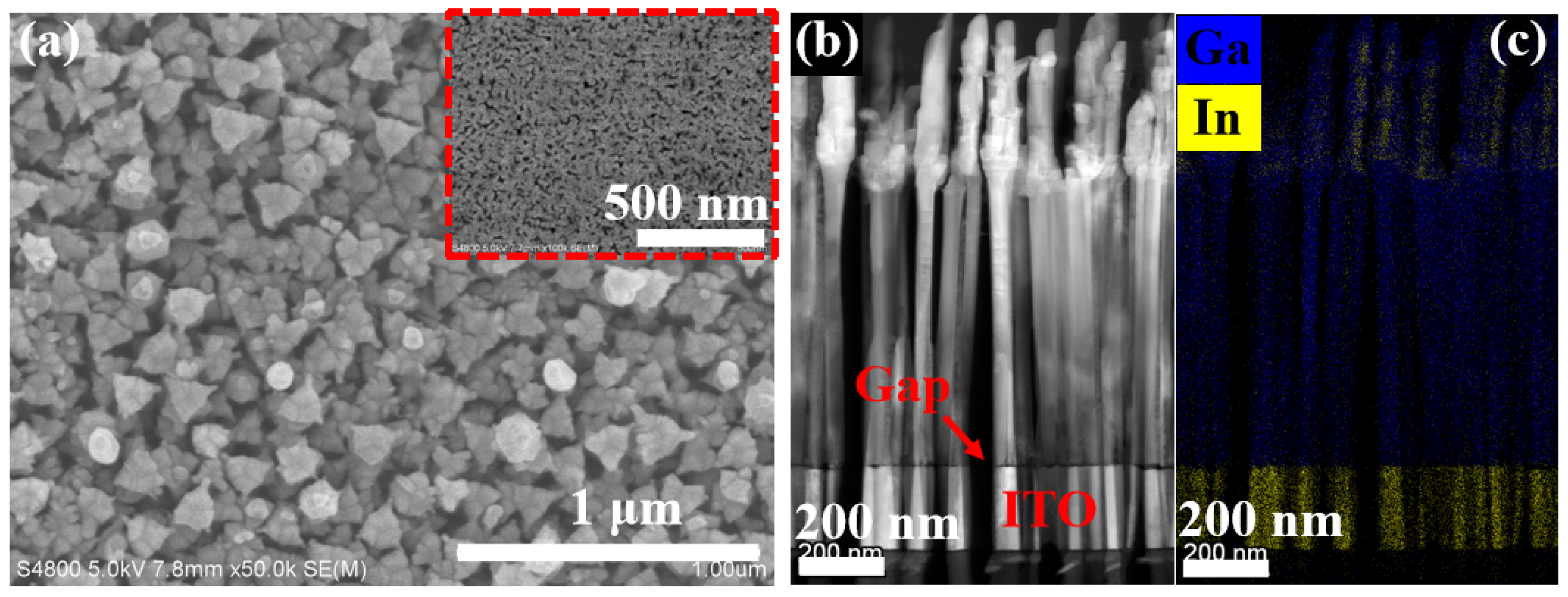

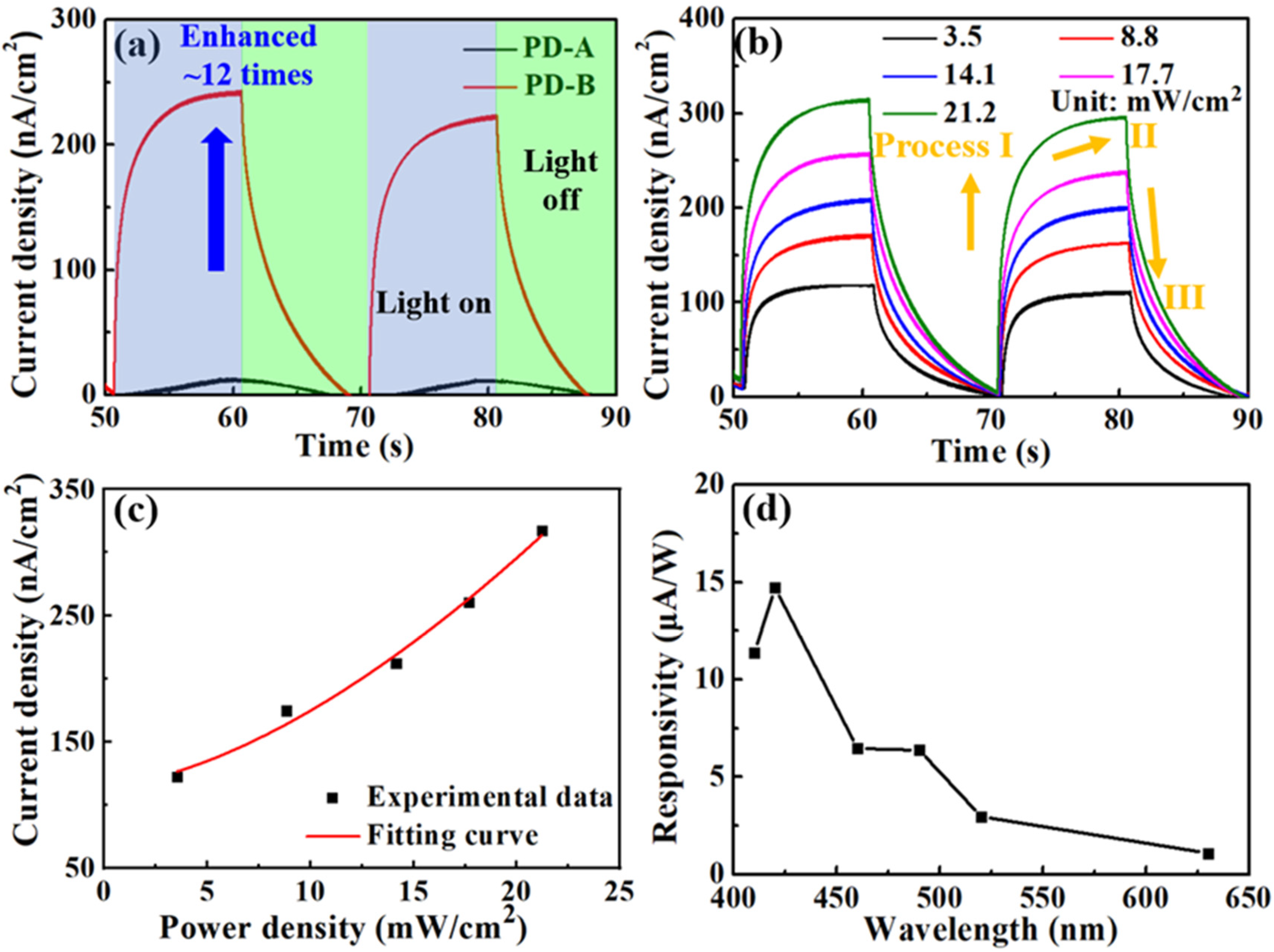
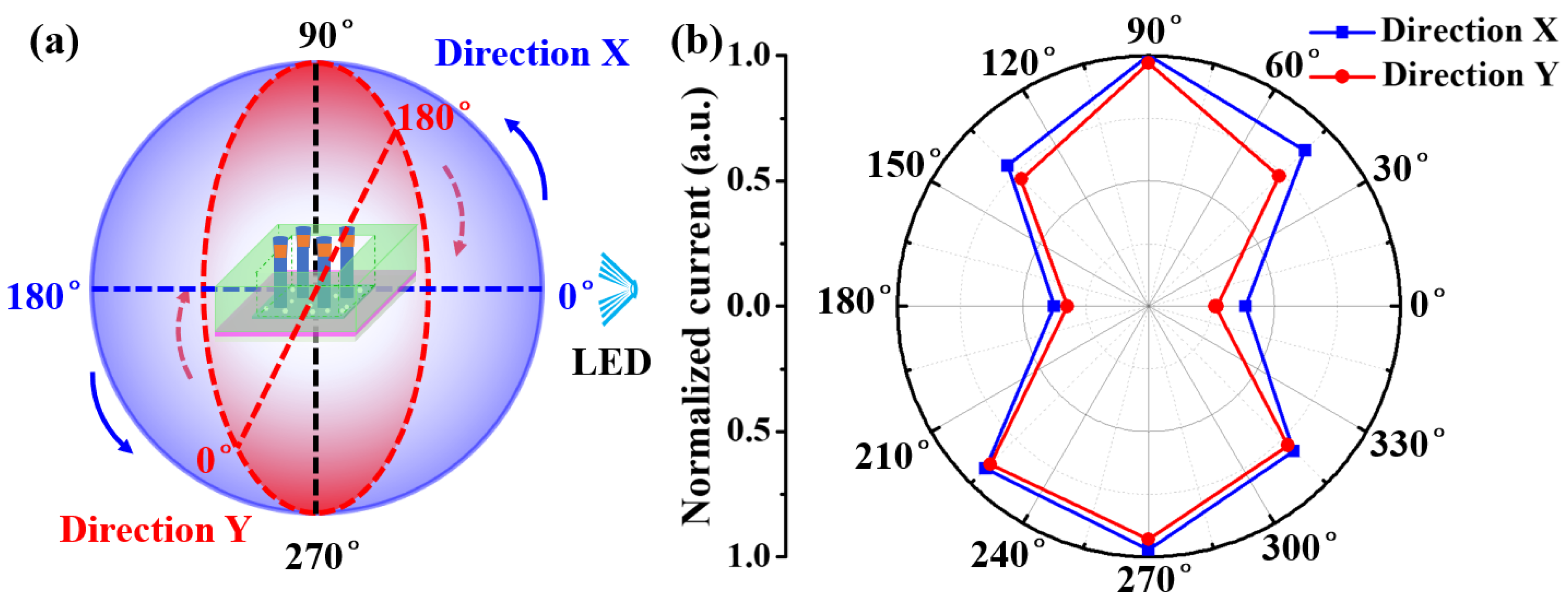
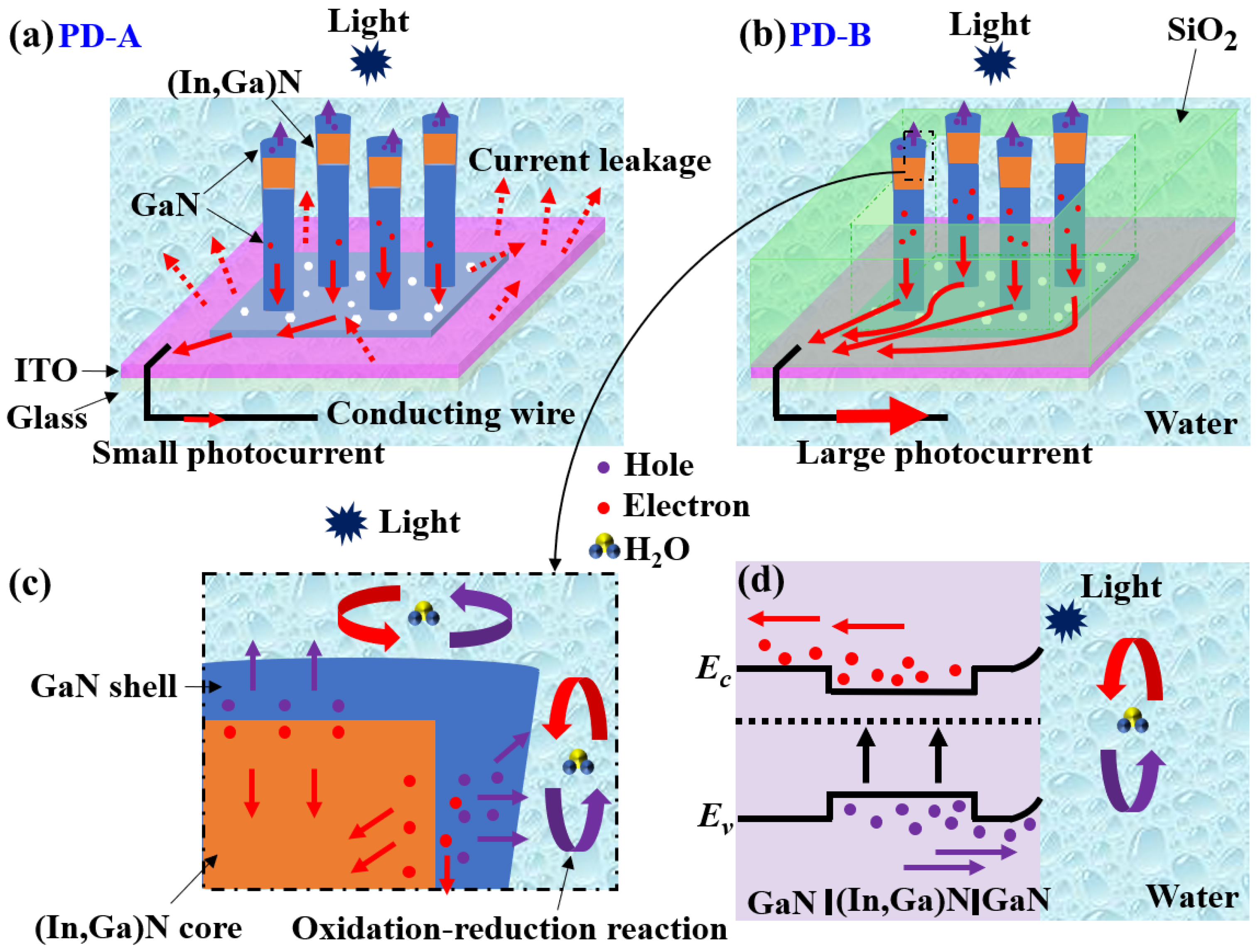
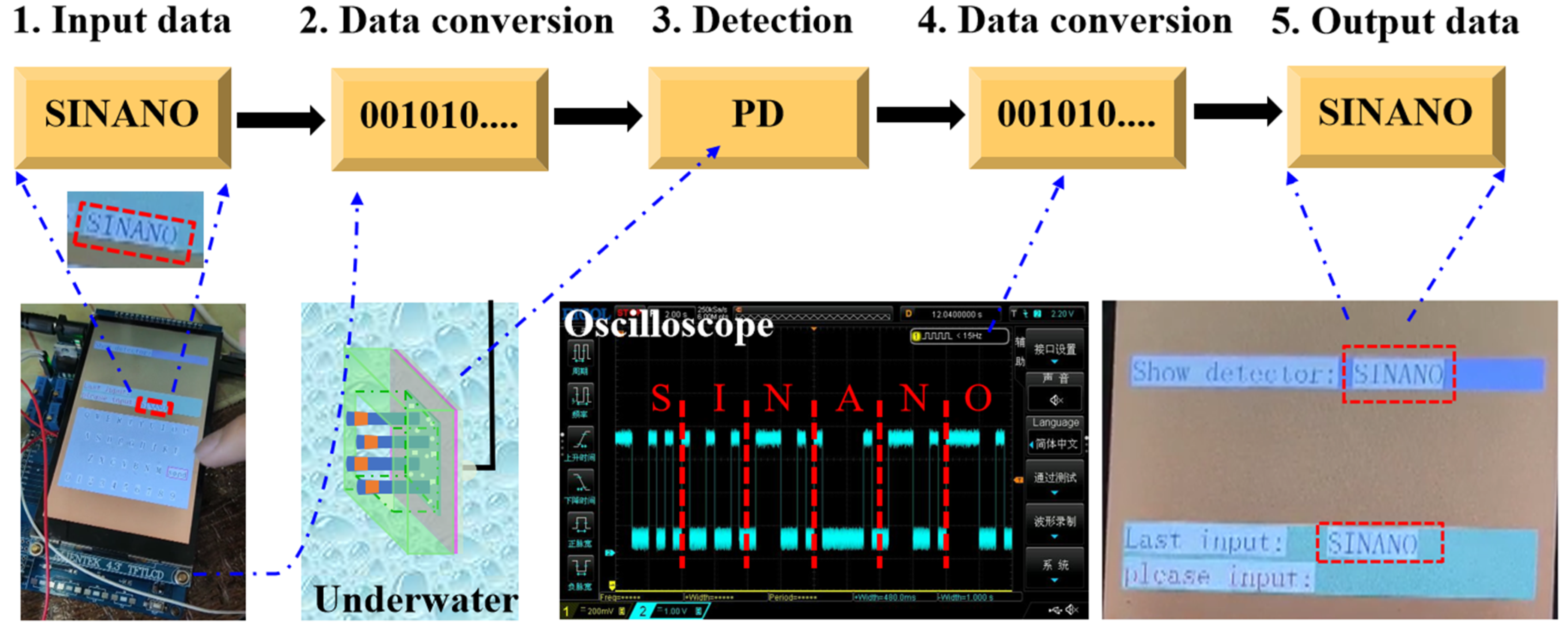
Publisher’s Note: MDPI stays neutral with regard to jurisdictional claims in published maps and institutional affiliations. |
© 2021 by the authors. Licensee MDPI, Basel, Switzerland. This article is an open access article distributed under the terms and conditions of the Creative Commons Attribution (CC BY) license (https://creativecommons.org/licenses/by/4.0/).
Share and Cite
Zhang, J.; Jiang, M.; Bian, L.; Wu, D.; Qin, H.; Yang, W.; Zhao, Y.; Wu, Y.; Zhou, M.; Lu, S. A Self-Powered Transparent Photodetector Based on Detached Vertical (In,Ga)N Nanowires with 360° Omnidirectional Detection for Underwater Wireless Optical Communication. Nanomaterials 2021, 11, 2959. https://doi.org/10.3390/nano11112959
Zhang J, Jiang M, Bian L, Wu D, Qin H, Yang W, Zhao Y, Wu Y, Zhou M, Lu S. A Self-Powered Transparent Photodetector Based on Detached Vertical (In,Ga)N Nanowires with 360° Omnidirectional Detection for Underwater Wireless Optical Communication. Nanomaterials. 2021; 11(11):2959. https://doi.org/10.3390/nano11112959
Chicago/Turabian StyleZhang, Jianya, Min Jiang, Lifeng Bian, Dongmin Wu, Hua Qin, Wenxian Yang, Yukun Zhao, Yuanyuan Wu, Min Zhou, and Shulong Lu. 2021. "A Self-Powered Transparent Photodetector Based on Detached Vertical (In,Ga)N Nanowires with 360° Omnidirectional Detection for Underwater Wireless Optical Communication" Nanomaterials 11, no. 11: 2959. https://doi.org/10.3390/nano11112959
APA StyleZhang, J., Jiang, M., Bian, L., Wu, D., Qin, H., Yang, W., Zhao, Y., Wu, Y., Zhou, M., & Lu, S. (2021). A Self-Powered Transparent Photodetector Based on Detached Vertical (In,Ga)N Nanowires with 360° Omnidirectional Detection for Underwater Wireless Optical Communication. Nanomaterials, 11(11), 2959. https://doi.org/10.3390/nano11112959








